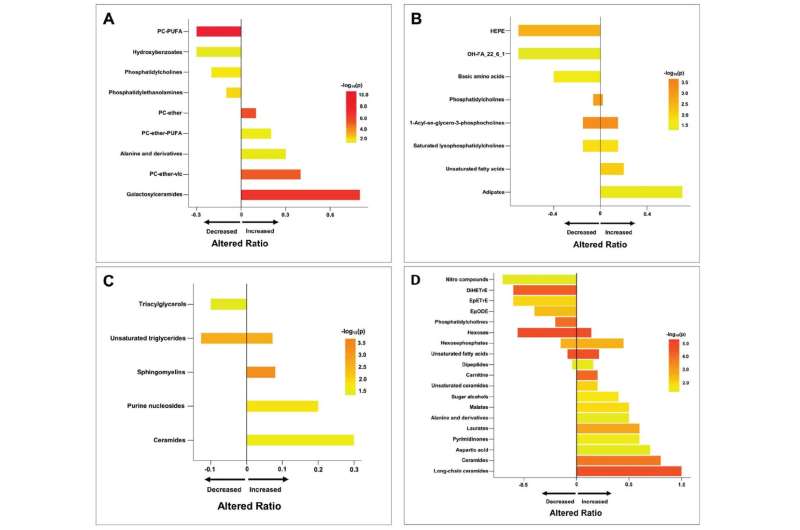This article has been reviewed according to Science X's editorial process and policies. Editors have highlighted the following attributes while ensuring the content's credibility:
fact-checked
peer-reviewed publication
trusted source
proofread
Molecular signatures in maternal and cord blood linked to autism risk

In a new study, researchers revealed disrupted levels of molecular compounds in maternal blood and cord blood are linked to later diagnosis of autism spectrum disorder (ASD). Identification of these compounds sheds light on the biological processes that give rise to ASD and could open the door to early diagnosis and treatment. The study was led by researchers at Columbia University Mailman School of Public Health and the Norwegian Institute of Public Health. Findings appear in the journal Molecular Psychiatry.
The researchers analyzed levels of 1,208 different chemical compounds in plasma samples collected from 408 mothers at mid-gestation (17-21 weeks) and in cord blood taken from 418 children at birth through the Norwegian Autism Birth Cohort (ABC).
The compounds were analyzed to see if they relate to clinical diagnosis of autism at ages 3-5. The researchers used chromatography/mass spectrometry-based metabolomics assays to measure levels of chemical compounds. They used machine learning to assess the predictive value of the compounds as biomarkers for ASD.
The researchers found 12 chemical compounds in maternal mid-gestation (MMG) samples of ASD girls, 3 compounds in MMG samples of ASD boys, 8 compounds in cord blood (CB) samples of ASD girls, and 12 compounds in CB samples of ASD boys to be linked to autism, including those that involve inflammation, disruption of membrane integrity, and impaired neurotransmission and neurotoxicity. Machine learning analyses suggested the potential utility of the compounds as biomarkers, especially those in cord blood, for early identification of children at risk for ASD.
The study identifies several differences in levels of biomarkers between boys and girls, including an imbalance of lipid chemical clusters in the maternal blood related to autism in girls, not boys. The finding may provide insight into the higher frequency of cognitive impairment in girls than in boys with ASD.
The study builds on research published by the same group of scientists in 2022 which found ASD risk was linked to groupings of inflammation-related molecules.
"Our latest findings add to evidence that chemical compounds can be harnessed as an early biomarker for autism spectrum disorder with rapid developments in machine learning suggesting such a diagnostic test is feasible," says first author Xiaoyu (Jason) Che, Ph.D., assistant professor of biostatistics in the Center for Infection and Immunity (CII) at Columbia Mailman School of Public Health.
"The Autism Birth Cohort (ABC) is nested in the large population-based Norwegian Mother, Father, and Child Cohort Study (MoBa) where more than 114,000 offspring and their parents participate. Mothers and fathers were recruited in early pregnancy between 1999 and 2009. Children's ASD diagnoses have been obtained primarily through linkage with national registries. ABC, MoBa, and registry data together are a unique resource for the current study and for future research on causes of ASD," says Camilla Stoltenberg, MD, co-author, director general at the Norwegian Institute of Public Health, and a co-founder of the ABC study.
"Approximately 1 in 44 children in the United States has an autism spectrum disorder. Interventions are most effective when implemented early. However, the mean age for diagnosis is age 4-5 years. Thus, in addition to providing insights into the pathogenesis of these disorders, our findings may lead to tests for early diagnosis that improve outcomes," says senior author W. Ian Lipkin, MD, John Snow Professor of Epidemiology and director of CII.
More information: Xiaoyu Che et al, Metabolomic analysis of maternal mid-gestation plasma and cord blood in autism spectrum disorders, Molecular Psychiatry (2023). DOI: 10.1038/s41380-023-02051-w





















